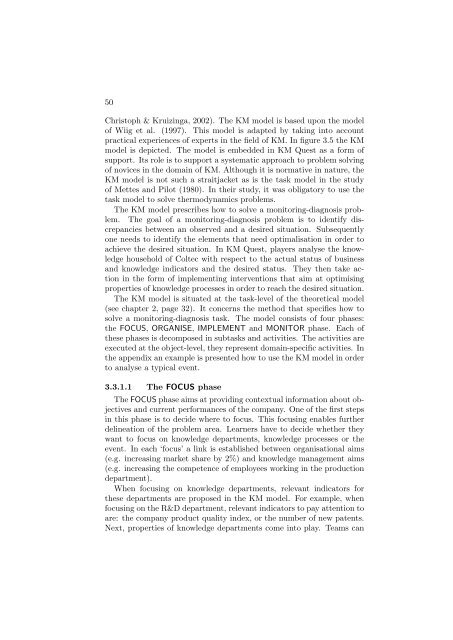The role of metacognitive skills in learning to solve problems
The role of metacognitive skills in learning to solve problems
The role of metacognitive skills in learning to solve problems
You also want an ePaper? Increase the reach of your titles
YUMPU automatically turns print PDFs into web optimized ePapers that Google loves.
50<br />
Chris<strong>to</strong>ph & Kruiz<strong>in</strong>ga, 2002). <strong>The</strong> KM model is based upon the model<br />
<strong>of</strong> Wiig et al. (1997). This model is adapted by tak<strong>in</strong>g <strong>in</strong><strong>to</strong> account<br />
practical experiences <strong>of</strong> experts <strong>in</strong> the field <strong>of</strong> KM. In figure 3.5 the KM<br />
model is depicted. <strong>The</strong> model is embedded <strong>in</strong> KM Quest as a form <strong>of</strong><br />
support. Its <strong>role</strong> is <strong>to</strong> support a systematic approach <strong>to</strong> problem solv<strong>in</strong>g<br />
<strong>of</strong> novices <strong>in</strong> the doma<strong>in</strong> <strong>of</strong> KM. Although it is normative <strong>in</strong> nature, the<br />
KM model is not such a straitjacket as is the task model <strong>in</strong> the study<br />
<strong>of</strong> Mettes and Pilot (1980). In their study, it was obliga<strong>to</strong>ry <strong>to</strong> use the<br />
task model <strong>to</strong> <strong>solve</strong> thermodynamics <strong>problems</strong>.<br />
<strong>The</strong> KM model prescribes how <strong>to</strong> <strong>solve</strong> a moni<strong>to</strong>r<strong>in</strong>g-diagnosis problem.<br />
<strong>The</strong> goal <strong>of</strong> a moni<strong>to</strong>r<strong>in</strong>g-diagnosis problem is <strong>to</strong> identify discrepancies<br />
between an observed and a desired situation. Subsequently<br />
one needs <strong>to</strong> identify the elements that need optimalisation <strong>in</strong> order <strong>to</strong><br />
achieve the desired situation. In KM Quest, players analyse the knowledge<br />
household <strong>of</strong> Coltec with respect <strong>to</strong> the actual status <strong>of</strong> bus<strong>in</strong>ess<br />
and knowledge <strong>in</strong>dica<strong>to</strong>rs and the desired status. <strong>The</strong>y then take action<br />
<strong>in</strong> the form <strong>of</strong> implement<strong>in</strong>g <strong>in</strong>terventions that aim at optimis<strong>in</strong>g<br />
properties <strong>of</strong> knowledge processes <strong>in</strong> order <strong>to</strong> reach the desired situation.<br />
<strong>The</strong> KM model is situated at the task-level <strong>of</strong> the theoretical model<br />
(see chapter 2, page 32). It concerns the method that specifies how <strong>to</strong><br />
<strong>solve</strong> a moni<strong>to</strong>r<strong>in</strong>g-diagnosis task. <strong>The</strong> model consists <strong>of</strong> four phases:<br />
the FOCUS, ORGANISE, IMPLEMENT and MONITOR phase. Each <strong>of</strong><br />
these phases is decomposed <strong>in</strong> subtasks and activities. <strong>The</strong> activities are<br />
executed at the object-level, they represent doma<strong>in</strong>-specific activities. In<br />
the appendix an example is presented how <strong>to</strong> use the KM model <strong>in</strong> order<br />
<strong>to</strong> analyse a typical event.<br />
3.3.1.1 <strong>The</strong> FOCUS phase<br />
<strong>The</strong> FOCUS phase aims at provid<strong>in</strong>g contextual <strong>in</strong>formation about objectives<br />
and current performances <strong>of</strong> the company. One <strong>of</strong> the first steps<br />
<strong>in</strong> this phase is <strong>to</strong> decide where <strong>to</strong> focus. This focus<strong>in</strong>g enables further<br />
del<strong>in</strong>eation <strong>of</strong> the problem area. Learners have <strong>to</strong> decide whether they<br />
want <strong>to</strong> focus on knowledge departments, knowledge processes or the<br />
event. In each ‘focus’ a l<strong>in</strong>k is established between organisational aims<br />
(e.g. <strong>in</strong>creas<strong>in</strong>g market share by 2%) and knowledge management aims<br />
(e.g. <strong>in</strong>creas<strong>in</strong>g the competence <strong>of</strong> employees work<strong>in</strong>g <strong>in</strong> the production<br />
department).<br />
When focus<strong>in</strong>g on knowledge departments, relevant <strong>in</strong>dica<strong>to</strong>rs for<br />
these departments are proposed <strong>in</strong> the KM model. For example, when<br />
focus<strong>in</strong>g on the R&D department, relevant <strong>in</strong>dica<strong>to</strong>rs <strong>to</strong> pay attention <strong>to</strong><br />
are: the company product quality <strong>in</strong>dex, or the number <strong>of</strong> new patents.<br />
Next, properties <strong>of</strong> knowledge departments come <strong>in</strong><strong>to</strong> play. Teams can
















